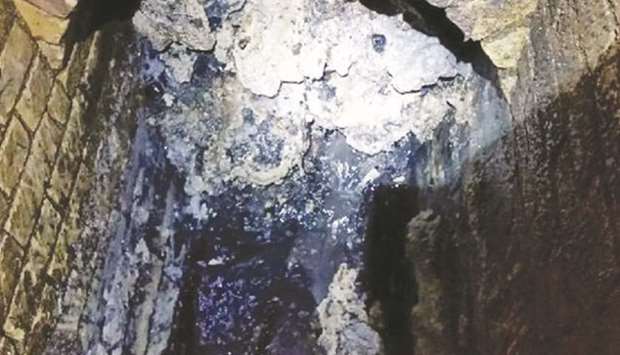The congealed mass of fat, wet wipes and nappies is one of the biggest ever found and would have risked raw sewage flooding on to the streets in Whitechapel, east London, had it not been discovered during a routine inspection earlier this month.
Now workmen armed with shovels and high-powered jets are working seven days a week to break it up. The grim task is expected to take three weeks.
Thames Water’s head of waste networks, Matt Rimmer, said: “This fatberg is up there with the biggest we’ve ever seen. It’s a total monster and taking a lot of manpower and machinery to remove as it’s set hard.
“It’s basically like trying to break up concrete. It’s frustrating as these situations are totally avoidable and caused by fat, oil and grease being washed down sinks and wipes flushed down the loo.”
The fatberg is estimated to weigh 130 tonnes and stretches for 250 metres making it 10 times larger than the one found in a sewer in Kingston, London, in 2013.
The crew trying to break it up are equipped with special protective suits and at times will have to hack away at the fatberg with shovels. The waste will then be sucked up into tankers and taken for disposal at a recycling plant in Stratford.
Rimmer said: “We check our sewers routinely but these things can build up really quickly and cause big problems with flooding, as the waste gets blocked. It’s fortunate in this case that we have only had to close off a few parking bays to get to the sewer. Often we have to shut roads entirely, which can cause widespread disruption, especially in London.”
CCTV camera inspections showed the 1,200mm high by 700mm wide sewer to be totally blocked by the fatberg, which is 3.5 metres deep.
Thames Water says it spends about £1mn a month clearing blockages from its sewers in London and the Thames Valley – an average of three fat-related blockages every hour. Earlier this year the company announced it was exploring whether it could use recovered fatbergs for biodiesel.
But Rimmer said the real solution was for consumers and business to dispose of fat and wipes in the bin. Engineers have also been visiting food outlets to discuss how they dispose of fat and food waste, plus offer advice on grease-trapping equipment for commercial kitchens.
“Yes, a lot of the fat comes from food outlets but the wipes and sanitary items are far more likely to be from domestic properties,” he said. “The sewers are not an abyss for household rubbish and our message to everyone is clear: please ‘bin it – don’t block it’.”



